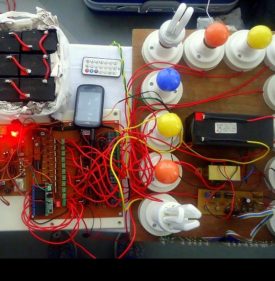CATEGORY: HARDWARE
29
Smart Automation
MAKERS: Ratiranjan
SMART AUTOMATION Rupesh Waiba, Ratiranjan Prajapati, Sujeet Singh Department of Electrical & Electronics Engineering, Reva Institute of Technology and Management kattingenhalli, Yelahanka, Bangalore Abstract In the present day world where communications have become highly mobile and personalized, both the benefi-ts and threats to government as well as private agencies are being revealed. Now leading to that predicament may extend to security system. So we have considered this project as a pa-rt of practical applications of Electrical and Power electronics as a breached and very secure type of lighting with embedded security system with minimum cost and best performance, as a alarm system will detect the presence of unauthorized entry onto ones premises. As we know that a smart alarm system protects the entire perimeter of around assigned home or pro-perty with proper lighting too. It alerts you and let the intrud-er being detected, it limits damage or at least and it brings up the help. A "smart automation system" may also include a device which emits a signal within a protected property only and is supervised by the proprietor of the property at all the available time, climatic condition and controlling it from any part of universe. Keywords DTMF, Inverter, LDR, Operational Amplif-ier, PIR sensor, Radio Frequency Module, TSOP sensor. I. INTRODUCTION Smart automation can be achieved with the presence of Sensor and remotes which controls the specified system so that it can be excellently used for the highly precise security system. This project takes us to a tour of advanced and controlled type of modern lighting with embedded security system. This system uses the different types of sensors and amplifiers to make the working of the circuits stable and reliable. II. WORKING It uses DTMF technology, PIR (Passive Infrared Ra-dial), LDR( Light Dependent Resistor), Condenser Mic, RF Module and TSOP sensors in this circuit including different power electronics devices. The operations of each important sensors are described below briefly. A. DTMF DTMF stands for dual tone multi frequency and it is the basis for your telephone system. when you press the button on the keypad, a connection is made that generates two ton-es at the same time. A "ROW" tone and a "COLUMN" tone. these two tones identify the key you pressed to any equipment you are controlling. If the keypad is on your ph-one, the telephone company's "central office" equipment know?s what you are dialling by these tones, and will swit-ch your call accordingly. If you are using a DTMF keypad to remotely control equipment, the tones can identify what unit you want to control, as well as unique function you want it to perform. 1 2 3 697 Hz 4 5 6 770 Hz 7 8 9 852 Hz * 0 # 941 Hz 1209 Hz 1336 Hz 1477 Hz when you press the digit 1 on the keypad, We generate the tones 1209Hz and 697Hz.pressing the digit 2 will generate the tones 1336Hz and 697Hz.sure ,the tone 697Hz is the same for both digit, but it takes two tones to make a digit and the decoding equipment knows the difference between 1209Hz that would complete the digit 1,and a 1336Hz that completes a digit 2, while the engineers were designing this protocol, they decided to throw in a few more "special pur-pose "tone groups. Normally we don't see these extra four buttons on telephones, but they are alive and being employ-ed for communication signalling. B. PIR SENSOR The PIR sensor is basically a pyroelectric device. When the device is exposed to infrared radiation, it generates an electric charge. The device is made of crystall-ine material. Thus the word ?passive? is used in PIR to explain that it does not emit a radiation and receive it, but instead accepts the incoming infrared radiation passively. The device contains a special filter called a Fresnel lens, which focuses the infrared signals onto the element. As the ambient infrared signals change rapidly, the on-board amplifier trips the output to indicate motion. We can say that the PIR sensor is a human body sensor because it is only activated when a human or animal walks past the sensor. PIR sensor will detect the movement of the human body around its prescribed radius which in turn it generates a low voltage signal and this is amplified using the operational amplifiers. C. LDR A photoresistor or light dependent resistor (LDR) or photocell is a resistor whose resistance decreases with inc-reasing incident light intensity. If light falling on the device is of high enough frequency, photons absorbed by the sem-iconductor give bound electrons enough energy to jump into the conduction band. The resulting free electron and its hole partner conduct electricity, thereby lowering resistan-ce Photoresistors come in many types. Inexpensive cadmi-um sulphide cells can be found in many consumer items such as camera light meters, street lights, clock radios, ala-rm devices, outdoor clocks, solar street lamps and solar ro-ad studs, etc. D. TSOP SENSOR The TSOP Sensor system is a miniaturized rece-iver for infrared remote control system. PN diode and pre-amplifier are assembled on lead frame, the epoxy package is designed as IR filter. . TSOP is the standard IR remote control receiver series, supporting all major trans-mission codes Photo detector and preamplifier are in one package having improved shielding against electrical field disturbance with TTL and CMOS compatibility.Remote can be of any type of television remote system or other too which can emit the infrared light pulses of frequency at or less than 38khz. E. INVERTER A power inverter, or inverter, is an electronic device or circuitry that changes direct current (DC) to alter-nating current (AC). The input voltage, output voltage and frequency, and overall power handling, are dependent on the design of the specific device or circuitry. A power inv-erter can be entirely electronic or may be a combination of mechanical effects (such as a rotary apparatus) and elect-ronic circuitry. Static inverters do not use moving parts in the conversion process. Inverters can be broadly classified into two types, voltage source and current source inverters. A voltage?fed inverter (VFI) or more generally a voltage?so-urce inverter (VSI) is one in which the dc source has small or negligible impedance. The voltage at the input term-inals is constant. A current?source inverter (CSI) is fed with adjustable current from the dc source of high impede-nce that is from a constant dc source. F. RF TECHNOLOGY Radio frequency (RF) is a rate of oscillation in the range of around 3 kHz to 300 GHz, which corresponds to the fr-equency of radio waves, and the alternating currents which carry radio signals. RF usually refers to electrical rather than mechanical oscillations. Although radio frequency is a rate of oscillation, the term "radio frequency" or its abbre-viation "RF" are also used as a synonym for radio ?i.e. to describe the use of wireless communication, as opposed to communication via electric wires. APPLICATIONS Smart automation have got wide range of application in today's modern society which is ac-hieved by the embedded security system. The app-lication of lightning and security system includes: 1 It is highly energy efficient designed system. 2 The control of any type of Electrical appliances can be achieved being miles away from the system. 3 Ease control system which can act as the master system to control the others. 4 Can be used in Irrigation control. 5 Very useful for the handicapped and elderly people. 6 Can be used by navy and aerospace departments as smart security system. 7 Burglar alarms: designed to warn of burglaries; this is often a smart alarm: the police or guards are warned for the burglar, which increases the chances of catching him or her. VIII. ADVANTAGES 1 The smart use of modern technology is done at best level. 2 It helps in reducing the wastage of energy. i.e increasing the efficiency of the system. 3 They prevent unauthorized access or at least ma-ke it more difficult. 4 Simple to handle and cost efficient. 5 It bears no signal interference; so long range tra-nsmission distance is possible through sensors. 6 Less technical maintainance is required and its easy in operation. 7 The constant protection from the alarm system is obtained which may be particularly comforting. 8 Better security system with less effort. IX. DISADVANTAGE 1 They require resources to run and stand by ener-gy to operate. 2 It may add complexity to the communication en-vironment. 3 This type of systems are automatic so sometimes they may be costly. X. CONCLUSION This paper presents a novel analytical model for Smart Automation and also focuses on how much the security system of present era has advanced. It also describes about the crucial role they play in our modern society, using the effic-ient resources present in our technical gener-ation creating a wide field of opportunity for the coming generation. So that advanced type of sy-stem automation can be created using the proper resources to live a secured and quality life by showing us the picture of future .It shows how we can control our property security with a click of a button when we are sitting miles away from home. XI. REFERENCES [1] http://www.circuitstoday.com/pir-sensor-based-security-system [2] http://www.alldatasheet.com/datasheet-pdf/pdf/320204/HOLTEK/HT761X_09.html [3] http://searchnetworking.techtarget.com/definition/DTMF [4] http://en.wikipedia.org/wiki/Passive_infrared_sensor [5] www.biltek.tubitak.gov.tr/gelisim/elektronik/.../LDR_NSL19_M51.pdf? [6] http://www.engineersgarage.com/electronic-components/tsop1738-datasheet


